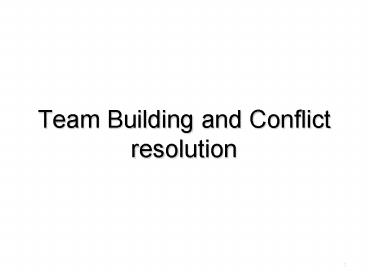Team Building and Conflict resolution - PowerPoint PPT Presentation
1 / 18
Title:
Team Building and Conflict resolution
Description:
Team Building and Conflict resolution Group/Team Dynamics Groups have 2 or more members Relatively stable structure, pattern of interaction Members see themselves as ... – PowerPoint PPT presentation
Number of Views:656
Avg rating:3.0/5.0
Title: Team Building and Conflict resolution
1
Team Building and Conflict resolution
2
Group/Team Dynamics
- Groups have 2 or more members
- Relatively stable structure, pattern of
interaction - Members see themselves as part of the group
3
Teams - Advantages
- Wider range of knowledge, expertise and idea
- Effective way to build consensus
- Effective way to communicate complex information
4
Teams
- Advantages
- wider range of knowledge, expertise and ideas
- effective way to build consensus
- effective way to communicate complex information
- Disadvantages
- blocking
- dominant people
- status differential
- motivation
- coordination
- groupthink
5
Group Development
- Forming
- Storming
- Norming
- Performing
- Adjourning
6
Forming (much uncertainty)?
- Questions about purpose
- Approach - avoidance behavior
- High drop out possibility
- Commitment from only a few members
- Members seek leadership
- Non-intimate relations
- Politeness likely
- Logistics need to be sorted out
7
Storming (intragroup conflict)?
- Resource inventory established
- Members test others strength
- Authority in group tested
- Fluid status structure
- Autonomy vs. Group membership expressed
- Fight or flight
- Dyads, cliques, fractions, etc. may form
- Member ejection may occur
8
Norming (close cohesiveness)?
- Intensified, interpersonal involvement
- Desire for group attention
- Member interdependence
- Dependence on the leader
- Increased trust
- Well established norms
- Rules, roles, standards
- Growing capacity to plan
9
Performing (functionality)?
- Sense that our group is special
- Acceptance of individual differences
- People can be themselves
- Disagreement/conflict is OK
- Structure, roles, norms established and accepted
- Teamwork utilizes the diverse strength of the
members
10
Adjourning
- Celebrate individual/collective accomplishments
- Members decide on what to bring into future
relations
11
Alternative View
- Team characteristics
- Team member characteristics
- Members past history and experience with other
members - Nature of the task and the technology available
- Environmental demands and constraints
12
(No Transcript)
13
Use Start-Stop-Keep to give each other feedback
Start Why?
Stop Why?
Keep Why?
14
Kick-Off workshop
- The purpose of this initial period is to begin
the forming process. - During this first week there will be a few small
exercises that will help the team member begin to
form relationships.
15
First In-between Period
- The teaching team will use the coaches and the
other experts to monitor the team development.
Given that sometime during this time will be the
storming period, this will be helpful know. - We expect to meet with the teams to see how they
are handling the storming and give assistance, if
required. While we will be there and will provide
tips, it is better for the team to work out these
issues themselves. - One assignment will be for the team to let us
know when they believe, the team roles have
solidified, what the roles are and who holds
them.
16
Mid-Term Workshop
- By this time the teams should be passed the
norming period and well into the performing.
However, team can fall backwards. So it will be
important to make sure where each team stands
before it is too late to meet the project plan
requirements. - But just because the team should be performing
well by now, it is the perfect time for problems
to occur. - Their will be some assignment related to conflict
resolution.
17
Second In-between Period
- The team should be busy in the middle of the
project. But are they working at their peak?
Extreme teams work under enormous time and or
resource pressure and have extraordinary results.
What can our teams learn from extreme teams that
will help them reach and extend their peak
performance period. - Their will be an assignment to explore this
question. As the project ends, the team will
enter the adjourning period. This can be a period
of high emotion so much so that the conclusion of
the project can be threatened. So this needs to
be monitored as well.
18
Final Workshop
- Extensive debriefing will occur
- The teams and the team members reflect on lessons
learned































